RECENTLY, local independent filmmakers released four short parodies to raise public awareness on the potential hazards of radioactive waste that is expected to be left behind by the Lynas rare earth refinery in Pahang.
Concerned with the public health impact of the processing plant located approximately 25km from Kuantan, local communities have formed anti-Lynas groups, held talks and rallies, and even raised their own funds to travel to Australia to lobby foreign lawmakers.
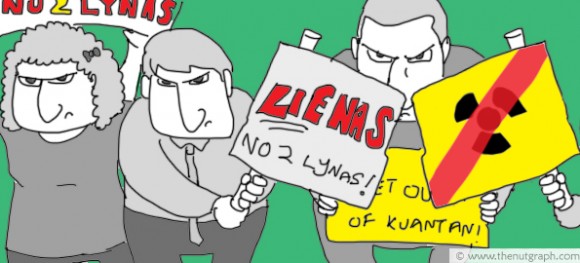 But the Pahang government, Lynas Corp as well as an Australian minister have claimed that the refinery is safe and meets international standards. What exactly is a rare earth refinery? Is it really dangerous? What impact will it have on the environment and people’s lives? What is the fuss really about?
But the Pahang government, Lynas Corp as well as an Australian minister have claimed that the refinery is safe and meets international standards. What exactly is a rare earth refinery? Is it really dangerous? What impact will it have on the environment and people’s lives? What is the fuss really about?
What is the Lynas project all about?
Rare earth metals are increasingly being used to manufacture high-tech products from smart phones to hybrids cars to bombs. Despite its name, rare earths are relatively abundant and can be found in many countries.
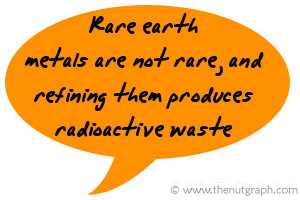 However, the process of refining rare earth ore, which often contains radioactive elements such as thorium and uranium, leaves behind thousands of tonnes of low-level radioactive waste. Malaysia learnt the lesson the hard way from Bukit Merah in Perak, where Mitsubishi Chemical is still spending millions cleaning up the site two decades after the refinery was closed in 1992.
However, the process of refining rare earth ore, which often contains radioactive elements such as thorium and uranium, leaves behind thousands of tonnes of low-level radioactive waste. Malaysia learnt the lesson the hard way from Bukit Merah in Perak, where Mitsubishi Chemical is still spending millions cleaning up the site two decades after the refinery was closed in 1992.
Consequently, not many countries are keen to refine rare earths and China now mines and refines 95% of global supply. Lynas’s nearly completed RM700 million refinery in Gebeng will be the first rare earth processing plant to be built outside China in nearly three decades.
Lynas will be shipping the ore from Mount Weld, Western Australia to be processed in Gebeng. Once up and running, the Lynas refinery will break China’s monopoly on global rare earth supply.
Impact on environment and people?
The main concerns that have been raised about the refinery are related to the operating plant’s infrastructure and its waste management plant.
The New York Times reported on 29 June 2011 that current and former engineers of the Lynas plant have expressed concerns about the plant’s construction and design flaws.
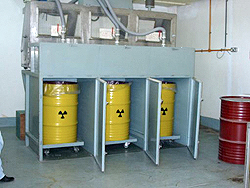
“The problems [the engineers] detail include structural cracks, air pockets and leaks in many of the concrete shells for 70 containment tanks, some of which are larger than double-decker buses. Ore…would be mixed with powerful acids to make a slightly radioactive slurry that would be pumped through the tanks, with operating temperatures of about 200 degrees Fahrenheit.
“The engineers also say that almost all of the steel piping ordered for the plant is made from standard steel, which they describe as not suited for the corrosive, abrasive slurry. Rare earth refineries in other countries make heavy use of costlier stainless steel or steel piping with ceramic or rubber liners,” The New York Times journalist Keith Bradsher highlighted. There were other construction concerns.
Lynas Corp executive chairperson Nicholas Curtis has dismissed the influential daily’s report as arising from “debate” that is to be expected among engineers. Curtis added that all the issues have since been resolved and gave an assurance that the plant would be safe. However, he did not respond to the specific engineering flaws that were raised in The New York Times report except to state that “every piece of piping has been engineered in accordance with the necessary conditions to contain that material safely and there is a wide variety of materials used in the piping”.
The International Atomic Energy Agency (IAEA) has also proclaimed that the Lynas refinery’s overall design and operations procedures meet international radiation safety standards. However, after a June 2011 visit, nine IAEA experts made 11 recommendations to improve the refinery’s safety to our government regulator, the Atomic Energy Licensing Board. IAEA recommended that Lynas should be required to fulfill the conditions below before being allowed to start operations:
1. To submit a plan setting out its intended approach to long-term waste management, in particular of water leach purification (WLP) solids, after the plant’s closure. This plan must take into account various safety aspects and protocol.
2. To submit a plan for managing the waste from the decommissioning and dismantling of the plant at the end of its life.
3. To make the necessary financial provision for establishing a fund to cover the cost of the long-term management of waste including decommissioning and remediation.
4. To intensify its communication with interested and affected parties in order to demonstrate how it will ensure the public’s and the environment’s radiological safety.
Lessons from Bukit Merah?
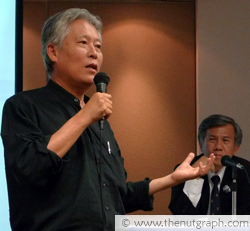
In a 2 Dec 2011 public forum at the Bar Council, chemical and environmental engineer Dr Tan Kak Heng estimated that Lynas was expected to produce 230,000 tonnes of toxic waste annually. This will amount to 6.9 million tonnes of waste in the 30 years the refinery is expected to operate.
He claimed that 1,000 hectares of land would be needed to bury the waste but a permanent dump site to store this waste has yet to be identified in Malaysia.
“Who will foot the cost to manage this waste and decommission the refinery – Lynas or Malaysian taxpayers?” he asked. In 1987, Tan was detained without trial for two years under the Internal Security Act (ISA) during Operasi Lalang for speaking out on Bukit Merah.
“There were eight leukemia cases in Bukit Merah within a five kilometer radius in a span of five years. Seven (patients) have since died,” said occupational health and safety specialist Dr T Jayabalan also at the Bar Council forum. Dr Jayabalan investigated the health impact of the Asian Rare Earth plant on the Bukit Merah community in the 1980s. He said based on an academic study, there should only have been one leukemia case every 30 years in a population the size of Bukit Merah’s then.
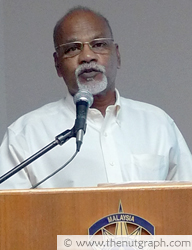
“It wasn’t a coincidence. The children I tested had high levels of lead in their bodies. When I arranged for them to be moved out of their community for a period of time, their blood lead level decreased significantly,” Dr Jayabalan testified.
Learning from Bukit Merah’s painful lessons, Kuantan residents have valid grounds to demand that Lynas make public its long-term waste management plan to allay their fear of radioactive leakages.
Be it in China or Malaysia, rare earth refineries are here to stay with rising global demand for the metals. But as in the case with radioactive waste produced from nuclear power, a permanent dumpsite, remote from human population, is difficult to find to bury harmful, toxic waste.
And the pertinent moral question remains: Do we want to continue to leave behind such a toxic legacy that will likely outlive our smart phones, hybrid cars and human civilizations? ![]()
Gan Pei Ling is not against the rare earth refinery but supports community groups’ efforts to hold the government and Lynas accountable. Public health interests should always trump corporate profit.


John Ho says
Regarding Bukit Merah – was the issue radiation or lead poisoning? The Lynas plans say radiation levels will be 37 times lower than Bukit Merah. Radiation-monitoring systems are operational in Gebeng and Kuantan, and operations will shut down if it exceeds safe levels.
Yeo Kien Kiong says
Three questions that I hope somebody can help explain:
1. If Lynas claims it is safe to have the plant’s infrastructure, and waste management is safe from radioactive harm towards human beings, why doesn’t the company ship [the waste] back to their home country?
2. Would the ministers or the government or supporters of Lynas dare to stay nearby the plant to prove to the citizens of Malaysia that the operations will be absolutely safe?
3. Malaysia has some of the oldest flora and fauna in the world. Would constructing the plant would be just another “rape” of the natural habitat and livelihood of indigenous peoples that give art, life and foundation to the natural environment?
Kenny says
Proponents of Lynas say jobs would be created for the locals.That may have some truth to it as Lynas is some of the biggest miners in Australia. But on the other hand, local people could also suffer thousand of job losses because state tourism will potentially be hurt by the radioactive material dumpsite in the state. Just imagine: thousand of workers from hotels, restaurants and shopping malls could get laid off as a result of poor tourist arrivals into Pahang.
I hope that the authorities can consider wisely the consequences and merits if such approval is given. They can’t have it both ways.